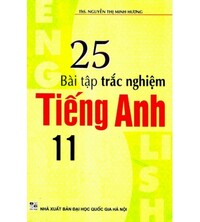Tiếng Anh 11 Unit 2 2.4 Reading
1. In pairs, decide if the statements are true (T) or false (F). 2. Read the leaflet and check your answers to Exercise 1. 3. Read the article on page 23 and answer the questions. Who: 4. Read the article again. For questions 1-4, choose the correct answer, A, B, C or D. 5. Complete the questions with the correct form of the verbs in blue in the article. In pairs, ask and answer the questions.
Bài 1
1. In pairs, decide if the statements are true (T) or false (F).
(Làm theo cặp, quyết định xem các câu phát biểu là đúng (T) hay sai (F).)
1. A child dies from malaria every hour.
2. Malaria is contagious - you can catch it from other people.
3. You can only get malaria from a female mosquito.
4. Mosquitoes bite mainly in the afternoon.
5. If you get malaria, you will die - there is no treatment.
Lời giải chi tiết:
1. F
A child dies from malaria every hour.
(Mỗi giờ lại có một trẻ em chết vì sốt rét.)
2. F
Malaria is contagious - you can catch it from other people.
(Bệnh sốt rét dễ lây lan - bạn có thể lây bệnh từ người khác.)
3. T
You can only get malaria from a female mosquito.
(Bạn chỉ có thể bị sốt rét từ một con muỗi cái.)
4. F
Mosquitoes bite mainly in the afternoon.
(Muỗi đốt chủ yếu vào buổi chiều.)
5. F
If you get malaria, you will die - there is no treatment.
(Bị sốt rét thì chết - không có thuốc chữa.)
Bài 2
2. Read the leaflet and check your answers to Exercise 1.
(Đọc tờ rơi và kiểm tra câu trả lời của bạn cho Bài tập 1.)
HOW TO END MALARIA
THE PROBLEM
• Malaria kills one million people every year.
• A child dies from malaria every sixty seconds.
• Malaria keeps more kids out of school than any other disease.
THE FACTS
• Malaria is not contagious.
• You can only catch malaria from a female mosquito.
• Mosquitoes bite mainly at night.
THE SOLUTION
• Education! Education! Education!
• Help us to raise money to educate kids about malaria and buy medicine and mosquito nets!
Phương pháp giải:
Tạm dịch:
VẤN ĐỀ
• Sốt rét giết chết một triệu người mỗi năm.
• Cứ sáu mươi giây lại có một đứa trẻ chết vì sốt rét.
• Bệnh sốt rét khiến nhiều trẻ em phải nghỉ học hơn bất kỳ bệnh nào khác.
SỰ THẬT
• Bệnh sốt rét không lây nhiễm.
• Bạn chỉ có thể bị nhiễm bệnh sốt rét từ một con muỗi cái.
• Muỗi đốt chủ yếu vào ban đêm.
GIẢI PHÁP
• Giáo dục! Giáo dục! Giáo dục!
• Hãy giúp chúng tôi quyên góp tiền để giáo dục trẻ em về bệnh sốt rét và mua thuốc và màn chống muỗi!
Lời giải chi tiết:
1. F
A child dies from malaria every hour.
(Mỗi giờ lại có một trẻ em chết vì sốt rét.)
Thông tin: A child dies from malaria every sixty seconds.
(Cứ sáu mươi giây lại có một đứa trẻ chết vì sốt rét.)
2. F
Malaria is contagious - you can catch it from other people.
(Bệnh sốt rét dễ lây lan - bạn có thể lây bệnh từ người khác.)
Thông tin: Malaria is not contagious.
(Bệnh sốt rét không lây nhiễm.)
3. T
You can only get malaria from a female mosquito.
(Bạn chỉ có thể bị sốt rét từ một con muỗi cái.)
Thông tin: You can only catch malaria from a female mosquito.
(Bạn chỉ có thể bị nhiễm bệnh sốt rét từ một con muỗi cái.)
4. F
Mosquitoes bite mainly in the afternoon.
(Muỗi đốt chủ yếu vào buổi chiều.)
Thông tin: Mosquitoes bite mainly at night.
(Muỗi đốt chủ yếu vào ban đêm.)
5. F
If you get malaria, you will die - there is no treatment.
(Bị sốt rét thì chết - không có thuốc chữa.)
Thông tin: Help us to raise money to educate kids about malaria and buy medicine and mosquito nets!
(Hãy giúp chúng tôi quyên góp tiền để giáo dục trẻ em về bệnh sốt rét và mua thuốc và màn chống muỗi!)
Bài 3
3. Read the article on page 23 and answer the questions. Who:
(Đọc bài viết trang 23 và trả lời câu hỏi. Ai)
1. visited Hope's village?
2 . was sick with malaria?
3. gave Hope herbal medicine?
4. took her to the hospital?
5. had died from malaria two years before?
6. gave Hope an injection?
A STORY OF HOPE
Hope is a sixteen-year-old girl who got malaria and recovered. Her classmate tells her story here.
Hope was one of the best students in our class. But she had been absent from school for several weeks and we were worried. We decided to go to her village and find out what was wrong.
When we arrived, Hope's mother told us that Hope was sick with malaria. We were shocked - we knew how serious malaria could be. We asked how it had started. Hope's mother explained, 'One evening, Hope was really hot and had terrible headaches. She had no appetite. This went on for a few days. We thought that she had been in the sun too long. My husband gave Hope some herbal medicine, but it didn't help. Her condition began to get worse and she developed new symptoms. The fever got higher and she started vomiting. At this point, I was sure she had malaria, but I didn't know what to do.'
Her mother took Hope to the hospital. She didn't want to lose another child. Two years before, Hope's baby brother had fallen ill with malaria and died.
At the hospital, the doctor had examined Hope and diagnosed malaria. He had given her an injection and prescribed some medicine. And now she was getting better thanks to the treatment.
We asked if we could see her. We weren't worried about catching the disease - we knew that malaria was not contagious. At school we had learnt that you catch malaria at night, from female mosquitoes. So we were upset to see that. Hope was sleeping without a mosquito net.
We know that she was very lucky to recover from this disease that kills one baby every sixty seconds.
Real Life Stories. 2 April
Phương pháp giải:
Tạm dịch:
CÂU CHUYỆN HY VỌNG
Hope là một cô gái mười sáu tuổi bị sốt rét và đã khỏi bệnh. Bạn cùng lớp của cô ấy kể câu chuyện của cô ấy ở đây.
Hope là một trong những học sinh giỏi nhất trong lớp chúng tôi. Nhưng cô ấy đã nghỉ học vài tuần và chúng tôi rất lo lắng. Chúng tôi quyết định đến làng của cô ấy và tìm hiểu xem chuyện gì đã xảy ra.
Khi chúng tôi đến, mẹ của Hope nói với chúng tôi rằng Hope bị sốt rét. Chúng tôi đã bị sốc - chúng tôi biết bệnh sốt rét có thể nghiêm trọng như thế nào. Chúng tôi đã hỏi về dấu hiệu phát bệnh. Mẹ của Hope giải thích: 'Vào một buổi tối, Hope rất nóng và đau đầu kinh khủng. Con bé không thèm ăn. Điều này đã diễn ra trong một vài ngày. Mọi người nghĩ rằng do con bé đã ở ngoài nắng quá lâu. Chồng cô cho Hope uống thuốc thảo dược nhưng không đỡ. Tình trạng của con bé bắt đầu trở nên tồi tệ hơn và con bé xuất hiện các triệu chứng mới. Cơn sốt cao hơn và con bé bắt đầu nôn mửa. Lúc này, cô chắc chắn rằng con bé bị sốt rét, nhưng cô không biết phải làm gì'.
Mẹ Hope đã đưa cô đến bệnh viện. Cô không muốn mất thêm một đứa con. Hai năm trước, em trai của Hope bị sốt rét và qua đời.
Tại bệnh viện, bác sĩ đã khám cho Hope và chẩn đoán sốt rét. Anh ấy đã tiêm cho cô và kê một số loại thuốc. Và bây giờ cô ấy đã khỏe hơn nhờ được điều trị.
Chúng tôi hỏi liệu chúng tôi có thể gặp cô ấy không. Chúng tôi không lo lắng về việc mắc bệnh - chúng tôi biết rằng bệnh sốt rét không lây nhiễm. Ở trường, chúng tôi được biết rằng bạn bị sốt rét vào ban đêm, từ muỗi cái. Vì vậy, chúng tôi rất buồn khi thấy điều đó. Hope đã ngủ mà không có màn.
Chúng tôi biết rằng cô ấy đã rất may mắn khỏi căn bệnh này, căn bệnh giết chết một em bé cứ sau sáu mươi giây.
Chuyện Đời Thực. 2 tháng 4
Lời giải chi tiết:
1. Who visited Hope's village?
(Ai đến thăm Hope’s village?)
Her classmates visited Hope’s village.
(Bạn cùng lớp đã đến thăm làng của Hope.)
Thông tin: Hope was one of the best students in our class. But she had been absent from school for several weeks and we were worried. We decided to go to her village and find out what was wrong.
(Hope là một trong những học sinh giỏi nhất trong lớp chúng tôi. Nhưng cô ấy đã nghỉ học vài tuần và chúng tôi rất lo lắng. Chúng tôi quyết định đến làng của cô ấy và tìm hiểu xem chuyện gì đã xảy ra.)
2. Who was sick with malaria?
(Ai bị bệnh sốt rét?)
Hope was sick with malaria.
(Hope bị bệnh sốt rét.)
Thông tin: When we arrived, Hope's mother told us that Hope was sick with malaria.
(Khi chúng tôi đến, mẹ của Hope nói với chúng tôi rằng Hope bị sốt rét.)
3. Who gave Hope herbal medicine?
(Ai cho Hope uống thuốc thảo dược?)
Her father gave her herbal medicine.
(Bố cô ấy đã cho cô uống thuốc thảo dược.)
Thông tin: My husband gave Hope some herbal medicine, but it didn't help.
(Chồng cô cho Hope uống thuốc thảo dược nhưng không đỡ.)
4. Who took her to the hospital?
(Ai đưa cô ấy đến bệnh viện?)
Her mother took her to the hospital.
(Mẹ cô ấy đưa cô đến bệnh viện.)
Thông tin: Her mother took Hope to the hospital.
(Mẹ Hope đã đưa cô đến bệnh viện.)
5. Who had died from malaria two years before?
(Ai đã chết vì bệnh sốt rét hai năm trước?)
Hope’s baby brother had died from malaria two years before.
(Em trai của Hope đã mất do sốt rét 2 năm trước.)
Thông tin: Two years before, Hope's baby brother had fallen ill with malaria and died.
(Hai năm trước, em trai của Hope bị sốt rét và qua đời.)
6. Who gave Hope an injection?
(Ai đã tiêm cho Hope?)
The doctor gave her an injection.
(Bác sĩ đã tiêm cho cô ấy.)
Thông tin: At the hospital, the doctor had examined Hope and diagnosed malaria. He had given her an injection and prescribed some medicine.
(Tại bệnh viện, bác sĩ đã khám cho Hope và chẩn đoán sốt rét. Anh ấy đã tiêm cho cô và kê một số loại thuốc.)
Bài 4
EXAM FOCUS Multiple choice
4. Read the article again. For questions 1-4, choose the correct answer, A, B, C or D.
(Đọc lại bài viết. Đối với câu hỏi 1-4, chọn câu trả lời đúng, A, B, C hoặc D.)
1. The students went to visit Hope because
A. she was ill.
B. she needed some work from school.
C. they didn't know why she was away.
D. they lived near her village.
2. Hope's mother realised that Hope had malaria
A. because the herbal medicine didn't work.
B. after a really hot day in the sun.
C. because Hope stopped eating.
D. when Hope began to vomit.
3. What worried Hope's friends most when they saw her?
A. They thought they might catch malaria.
B. Hope wasn't sleeping.
C. Hope wasn't getting better.
D. Hope's bed didn't have a mosquito net.
4. What is the main message of this story?
A. Malaria is a deadly disease.
B. Hope is a very lucky girl.
C. Learning about malaria can save lives.
D. Doctors enjoy treating malaria.
Phương pháp giải:
Hope is a sixteen-year-old girl who got malaria and recovered. Her classmate tells her story here.
Hope was one of the best students in our class. But she had been absent from school for several weeks and we were worried. We decided to go to her village and find out what was wrong.
When we arrived, Hope's mother told us that Hope was sick with malaria. We were shocked - we knew how serious malaria could be. We asked how it had started. Hope's mother explained, 'One evening, Hope was really hot and had terrible headaches. She had no appetite. This went on for a few days. We thought that she had been in the sun too long. My husband gave Hope some herbal medicine, but it didn't help. Her condition began to get worse and she developed new symptoms. The fever got higher and she started vomiting. At this point, I was sure she had malaria, but I didn't know what to do.'
Her mother took Hope to the hospital. She didn't want to lose another child. Two years before, Hope's baby brother had fallen ill with malaria and died.
At the hospital, the doctor had examined Hope and diagnosed malaria. He had given her an injection and prescribed some medicine. And now she was getting better thanks to the treatment.
We asked if we could see her. We weren't worried about catching the disease - we knew that malaria was not contagious. At school we had learnt that you catch malaria at night, from female mosquitoes. So we were upset to see that. Hope was sleeping without a mosquito net.
We know that she was very lucky to recover from this disease that kills one baby every sixty seconds.
Lời giải chi tiết:
|
1. C |
2. D |
3. D |
4. C |
1. C
Các học sinh đến thăm Hope vì __________
A. cô ấy bị ốm.
B. cô ấy cần một số công việc từ trường học.
C. họ không biết tại sao cô ấy vắng.
D. họ sống gần làng của cô ấy.
Thông tin: But she had been absent from school for several weeks and we were worried. We decided to go to her village and find out what was wrong.
(Nhưng cô ấy đã nghỉ học vài tuần và chúng tôi rất lo lắng. Chúng tôi quyết định đến làng của cô ấy và tìm hiểu xem chuyện gì đã xảy ra.)
2. D
Mẹ Hope nhận ra Hope bị sốt rét __________
A. vì thảo dược không có tác dụng.
B. sau một ngày thực sự nóng dưới ánh mặt trời.
C. vì Hope ngừng ăn.
D. khi Hope bắt đầu nôn.
Thông tin: The fever got higher and she started vomiting. At this point, I was sure she had malaria, but I didn't know what to do.
(Cơn sốt cao hơn và con bé bắt đầu nôn mửa. Lúc này, cô biết chắc con bé bị sốt rét, nhưng cô không biết phải làm sao.)
3. D
Bạn bè của Hope lo lắng nhất khi họ nhìn thấy cô ấy là gì?
A. Họ nghĩ rằng họ có thể bị sốt rét.
B. Hope không ngủ.
C. Hope không khá hơn.
D. Giường của Hope không có màn.
Thông tin: So we were upset to see that. Hope was sleeping without a mosquito net.
(Vì vậy, chúng tôi rất buồn khi thấy điều đó. Hope đã ngủ mà không có màn.)
4. C
Thông điệp chính của câu chuyện này là gì?
A. Sốt rét là một căn bệnh chết người.
B. Hope là một cô gái rất may mắn.
C. Tìm hiểu về bệnh sốt rét có thể cứu mạng sống.
D. Bác sĩ thích điều trị bệnh sốt rét.
Bài 5
5. Complete the questions with the correct form of the verbs in blue in the article. In pairs, ask and answer the questions.
(Hoàn thành các câu hỏi với dạng đúng của các động từ màu xanh lam trong bài viết. Theo cặp hỏi và trả lời các câu hỏi.)
1. When was the last time you caught a cold or ______ ill?
2. What symptoms did you ______?
3. Did a doctor examine you, ______ any medicine or give you an injection?
4. How long did it take you to ______?
Phương pháp giải:
develop: phát triển, xuất hiện nhiều hơn
fall: ngã
prescribe: kê toa
catch + disease: mắc bệnh gì
recover + from: hồi phục khỏi cái gì
Lời giải chi tiết:
1. When was the last time you caught a cold or fell ill?
(Lần cuối cùng bạn bị cảm lạnh hoặc ngã bệnh là khi nào?)
2. What symptoms did you develop?
(Bạn đã xuất hiện thêm những triệu chứng gì?)
3. Did a doctor examine you, prescribe any medicine or give you an injection?
(Bác sĩ đã khám cho bạn, kê đơn thuốc hay tiêm cho bạn chưa?)
4. How long did it take you to recover?
(Bạn mất bao lâu để hồi phục?)
Bài 6
6. Work in groups. Discuss the following questions:
(Làm việc nhóm. Thảo luận các câu hỏi sau)
1. Is malaria a problem in Việt Nam?
(Bệnh sốt rét có phải là vấn đề ở Việt Nam?)
2. Why do some people in Việt Nam catch malaria?
(Tại sao một số người ở Việt Nam bị sốt rét?)
3. How can you help people around you prevent malaria?
(Bạn có thể giúp mọi người xung quanh ngừa bệnh sốt rết bằng cách nào?)
Lời giải chi tiết:
1. In my opinion, Việt Nam has a risk of malaria. Because the tropical climate zone exists in Việt Nam, while mosquitoes thrive in humidity and warm weather.
(Theo ý kiến của tôi, Việt Nam có nguy cơ bị bệnh sốt rét. Do Việt Nam thuộc vùng khí hậu nhiệt đới, trong khi muỗi lại phát triển mạnh trong điều kiện thời tiết ẩm và ấm.)
2. Because they often sleep without using nets and they live in wet, tree-lined places.
(Do họ thường ngủ mà không dùng màn và sông ở những nơi ẩm ướt, nhiều bóng cây.)
3. I will ask everyone to buy the net and use net when they go to sleep at night.
(Tôi sẽ kêu gọi mọi người mua màn và sử dụng màn khi họ đi ngủ vào ban đêm.)
Search google: "từ khóa + timdapan.com" Ví dụ: "Tiếng Anh 11 Unit 2 2.4 Reading timdapan.com"







